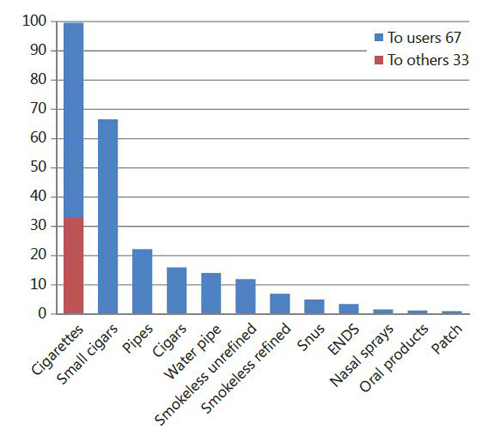What is tobacco harm reduction?
Quitting smoking and nicotine completely is clearly the most effective strategy for reducing the harm from smoking. However, smoking is a very powerful addiction and can be very hard to stop. Many smokers try and fail repeatedly to quit even with professional support and stop-smoking medications. Up to two in three continuing smokers will die prematurely from a smoking-related illness.
Tobacco harm reduction refers to switching to a less harmful nicotine product for those who are not able to quit smoking or nicotine use. Nicotine is the main reason people continue to smoke but it has relatively minor health effects, except in pregnancy. The focus is on preventing harm and not on preventing the use of nicotine itself.
Almost all the harm from smoking is caused by the thousands of toxins in smoke produced by burning tobacco. It is well known that ‘smokers smoke for nicotine but are killed by tar’. According to the UK Royal College of Physicians (p5):
if nicotine could be delivered effectively and acceptably to smokers without smoke, most if not all of the harm of smoking could probably be avoided
Products that deliver nicotine have different levels of risk, with cigarette smoking being the most harmful. The following graph shows the estimated risk of various nicotine-delivery products. E-cigarettes (ENDS) have an estimated 4% risk compared to cigarette smoking and nicotine patches have an estimated 2% risk. Tobacco harm reduction involves switching from the risky end of the spectrum to nicotine products at the less harmful (right) end of the range.

There are three smoke-free nicotine products which have been used by millions of smokers to quit globally. These are
- Electronic cigarettes
- Swedish snus
- Heated tobacco products (also known as heat-not-burn or HnB)
All these products deliver nicotine to satisfy nicotine cravings. Electronic cigarettes and HnB products have the added advantage of replicating the familiar hand-to-mouth ritual and sensations of smoking which smokers can find very hard to stop.
While not risk-free, the overwhelming scientific consensus is that these products deliver far lower levels of toxic and harmful compounds than combustible cigarettes. If a smoker switches completely from smoking he/she is likely to have substantial improvements in health.
Tobacco harm reduction is no different to other widely used harm reduction strategies used in public health. Other examples of harm reduction are
- Methadone for heroin users
- Clean needles and syringes and medically supervised injecting centres for injecting drug users
- Condom use by sex workers
The preferred goal from a health point of view is to stop smoking and then to stop the lower-risk nicotine product as well. However, it is far safer to use these products long-term than to relapse to smoking.